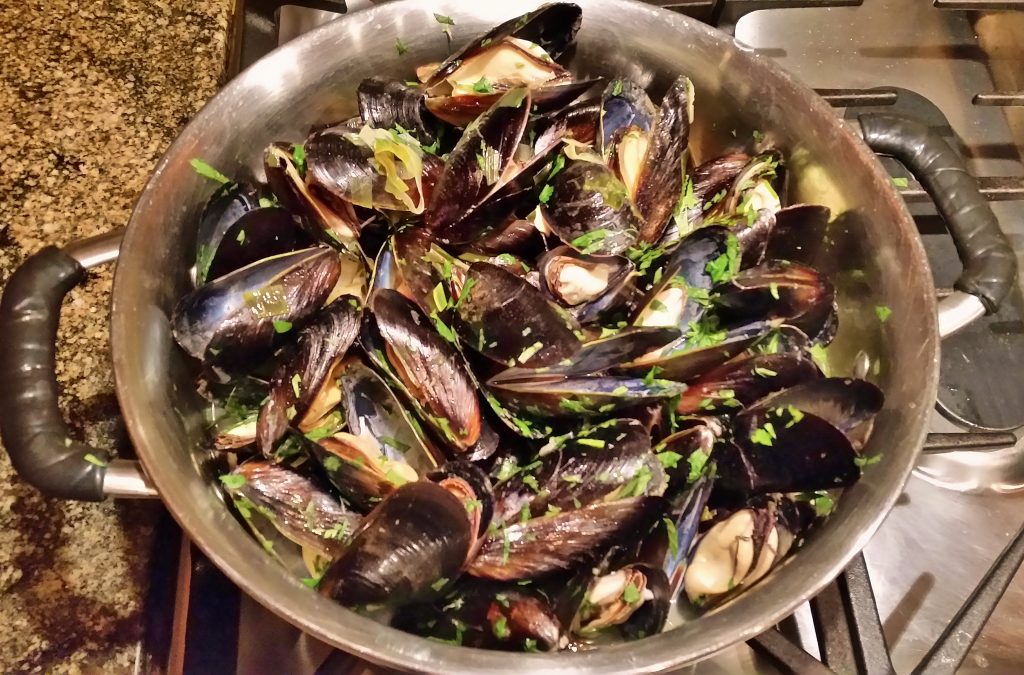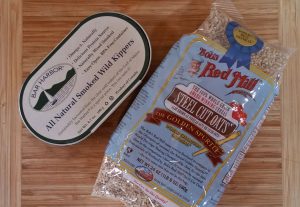
The farm, summer 2019.
Let me begin with a couple of announcements: First, I am not dead. I suspect that because book 5 did not come out in 2018 as I’d predicted it would, and because my website has not been updated with any new posts since July of 2018, some may have wondered.
Second, I apologize to anyone who has tried to contact me through my website since late last summer. Two things happened around that time. One was that Jeanette and I were hit with, to borrow a phrase from the title of a children’s book series, a series of unfortunate events. Dealing with them was all-consuming, and I did not even try to get to my website at all for the rest of 2018, or during this year until late last month. Second, around the end of August 2018, the hosting service where my website is located moved all of its hosted sites to new, upgraded servers. Unfortunately, the move disabled a number of features on my site, including the one that would notify me whenever a visitor had submitted a post so I could approve its publication on the site—a security feature to prevent trolling. So I didn’t realize people were attempting to post on the website or contact me through the site.
The server move also, as it turned out, automatically reset my password needed to log in to the administrative control panel for my site, from which I do things like make posts, approve visitors’ posts, etc., and it disabled the “send email” feature on the site which was necessary to reset the password if I could not log in successfully. So when I finally tried to get back to working on the site, including to begin working on this update, I discovered that I was effectively locked out of my own website with no way to get in. Only a few weeks ago was that problem finally resolved by a good friend and very savvy web programmer.
So…where is book 5? Back in my May 2018 post I was still hopefully predicting I could complete it by the end of the year. What happened?
The short and obvious answer is that I failed. I still have not yet completed it. There will be a book 5. I am working on it, and much of the story-line is thoroughly fleshed out. But there is still a lot of actual writing yet to be done. In truth, for reasons explained below, I made no progress at all on the book from August through the end of 2018, a period when I had been hoping a hard final push might get the job done.
If that’s all you wanted to know, feel free to stop reading here. But if you want to learn the details of all that has been going on in my life that has prevented me from finishing a very long awaited and long overdue next book, then read on for the long answer, because what happened to book 5 is due to all that has happened to my wife, Jeanette, and to me since late 2017. So let me explain, first by providing some background.
Seven years ago this past April Jeanette and I moved to our small farm in the foothills of the Cascade Mountains in western Oregon. It was a major leap of faith for several reasons. First, we were moving into a totally new lifestyle, a homestead farm existence, which neither of us had any prior experience with. Jeanette had been a cardiology nurse her entire adult life, while I had worked in criminal law, primarily as a police officer, federal agent, and prosecutor. With this move, neither of us would be working day jobs anymore (I had actually not worked outside the home for several years prior, due to a health issue). We were planning to support ourselves financially by a combination of income from my writing plus income from investments in the stock market I had made over many years. We also expected that as we produced more and more of our own food on the farm, we would hopefully see some reduction of our living expenses. So although neither of us would be holding outside jobs, working for someone else, in a sense our plan required each of us to juggle several jobs. I had four: writer, publisher, investment manager, and farmer, while Jeanette was my partner in publishing and the farm, and ran the household.
Our juggling act worked pretty well for the first several years here on the farm. Back then, the e-book market, which before around 2010 was a very minor segment of book publishing, was continuing to grow year by year as Amazon almost single-handedly strove to develop it. Amazon grew the e-book market by two methods. First, for a number of years during the early growth period of the market, each year as Christmas approached Amazon would offer new, improved versions of their Kindle e-book readers at low prices, to induce persons who had not yet tried e-book reading to take the plunge, or to give an e-reader as a gift to another. During this period, every January millions of new Kindle readers would come online, and their owners would be looking for e-books to buy. Amazon also grew the e-book market by establishing an easy-to-use self-publishing platform to allow authors to bypass the big publishers, publish their books directly, and keep a much higher percentage of the profits on sales of their work—70% of each book sale, versus the 10% to 15% big publishers paid (and still pay) authors. More and more authors, both established ones who were choosing to switch from working with a publisher, and many who’d never been published before, swarmed into e-book publishing, providing for Amazon (and for other e-book sellers such as Apple and Kobo, who eventually followed Amazon’s lead by creating self-publishing platforms) a huge supply of reasonably priced e-book content to sell. During those early years of the e-book market expansion, I saw my book sales grow and produce a strong income stream for us. The book sales in the early years on the farm were often more than enough to cover our monthly expenses, and if we occasionally needed a bit more, the returns I was receiving on my investments were more than adequate to cover the balance. So in those days I was able to let the investment side of our multi-faceted life for the most part drift along on auto-pilot without requiring much of my time or attention.
The farm side of this life has always been quite time consuming, however. In the early years there was a lot of learning of new skills and problem solving, and there is always a LOT of physical labor. During our first year we planted an orchard of nineteen fruit and nut trees on one side of the farm, around a single, ancient apple tree located there, which we over time pruned back into strong productivity. That work is finally beginning to pay off: last year we harvested numerous apples, a decent crop of peaches, and our first crops of pears (only two of those, and our big ram got to one before we did), cherries, and Kiwi fruit. In our first year here we bought chicks and raised them to become a source of eggs and, occasionally, meat. We’re in our fourth or fifth generation of chickens now, although one hen from the original batch of chicks is still alive, spry, and laying. Each year we have planted a large garden, producing significant quantities of numerous types of vegetables that we enjoy fresh during the summer and fall, and preserve by freezing and fermentation to enjoy over the winter. Because most of our five acre farm is open pasture (which I did not want to spend my time mowing), the first year we acquired a small herd—three ewes, each with a lamb—of heritage Soay sheep, the oldest domestic breed of sheep still in existence today, and the breed closest genetically to wild sheep. Our first year with the sheep was a struggle—we lost three to illness—but as the years passed our herd grew, and eventually we were able to start harvesting the excess rams for meat.

Dammit, our mature ram and leader of the herd.
During those early years here we were able to keep enough balance in our multi-sided life for me to complete writing and publish The Long Hunt, book 4 of the Strongbow Saga, in late 2013, to work with a narrator and produce all four books in audio format over the course of 2014, and to take a research trip to Ireland to support the planned final segment of the Strongbow Saga story, as well as a stand-alone novel set in the Strongbow Saga world, The Beast of Dublin, which I had been writing on and off since 2010.
I had hoped to complete The Beast of Dublin during 2015-2016 while the Ireland research was still fresh in my mind, but after spending some months working on it, I realized that my mind kept drifting back to the main Strongbow Saga story, so in mid-2015 I once again shelved the stand-alone book and began work on what I originally believed would be the fifth and final installment of Halfdan’s tale, with the intention of completing it during 2016.
The continuing Strongbow Saga story has long had a definite structure and conclusion in my mind. Part of my plan for the overall series was for readers to be able to experience, through Halfdan’s adventures and travels, almost the entire scope of the ninth century Viking world, including life in the Scandinavian homelands, expeditions for raiding and war in France, England, and Ireland, and the Vikings’ extensive trade routes in the east that connected the early northern medieval world with the middle east and the Eastern Roman Empire in Byzantium. After book 4, there were two story or plot arcs left to complete: the attempt to rescue Halfdan’s half-sister Sigrid, who had been sold into slavery by Toke in book 4, and the final hunting down of Toke and the resolution of his and Halfdan’s conflict. That final part of the story will take place mostly in Ireland, while the Sigrid story takes place in what is now northeastern Russia.
To write Sigrid’s story, I had first to thoroughly research the history and culture of the Vikings in the east. That proved to be much more of a challenge than I had anticipated. There are far fewer sources—both original ones dating from the Viking era plus modern analyses and interpretations—of the Vikings in the east than exist for the western Viking world, for which numerous studies, sources, and types of historical evidence exists. The Russian research ended up taking well over a year, bringing me into 2017 before I was finally ready to start writing book 5. And that, unfortunately, was when the juggling act of our lives here became badly unbalanced and much more of a challenge.
A number of things went wrong in 2017. First of all, it was the beginning of a period of higher than normal temperatures and drought in western Oregon. There are always wildfires in the northwest during the summer, but the wildfire season was especially bad in Oregon during 2017 due to the heat and drought. Several major fires burned not far from our farm—one about ten miles further upriver, and another on the other side of the mountain ridge that rises above the river directly behind us. During August, many days the smoke from the fires was as thick on our farm as heavy fog, and the air quality in the nearby Eugene-Springfield area was so bad that numerous outdoor events were cancelled.
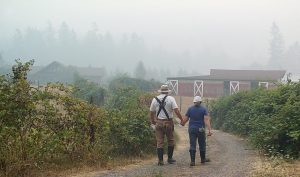
Smoke from nearby wildfires, summer 2017.
Our finances were no longer working out as planned by 2017, either—in fact, that problem had begun even before then, by 2016. The e-book market had reached maturity around 2014—huge numbers of readers were no longer joining for the first time every year. And the amount of e-book content available had grown to millions and millions of books, magazines, etc., making it much more difficult for any individual book or series to be found in searches on Amazon or other venues. Amazon’s search engines, which help readers find potential books to read, to some degree exacerbated the problem, because their programs decided which books to push to the front in searches in large part by sales rankings. So the lower your rate of sales were, the less likely your books were to be found, which lowered your sales further, which lowered your placement in searches further…you get the idea. As a result of all of this our monthly income from books sales began to gradually decline, and by 2016 had fallen off considerably.
At the same time that our book sale income was decreasing, one of our monthly expenses—the cost of medical insurance—was significantly increasing. In 2012, it cost a little over a thousand dollars per month for insurance coverage for both of us (and at the time, that seemed high). Since 2017, thanks to the repeated Republican efforts to destroy the Affordable Care Act, private insurance rates have risen so much that coverage for Jeanette alone is now over $1,200 per month. Thankfully, I’ve aged into Medicare, so my costs are considerably lower, but even so, currently many months our book sale income does little more than cover our combined medical insurance premiums, leaving the rest of our monthly expenses to have to be covered by other funds. And because the income from book sales had fallen so much, the amount I had been making in passive dividend income from my investments was no longer enough to bridge the gap between our income and expenses. So to make up the difference, during 2016 I began engaging in options trading to generate extra income by selling options contracts.
To give a brief and simplified explanation of what that entails, there are two basic forms of options contracts (there are also a number of more complex combined types of options trades, but I rarely used those). A Put is a contract where the seller offers to buy 100 shares of a particular stock—we’ll use XYZ as a hypothetical stock symbol—for a set price per share, called the strike price. The contract has a set expiration date, and if the stock’s price per share falls below the strike price when the contract expires (or before then, if the buyer of the contract chooses to exercise it early), the seller of the option contract must buy the 100 shares of XYZ from the buyer at the strike price. However, if at expiration the stock’s price is above the strike price, then the contract just expires, and the seller keeps the proceeds he received from selling the contract as pure profit. It is obviously somewhat of a gamble, and carries an amount of risk for the seller, but so long as prices in the stock market remain stable or the market is rising, it’s possible to make a decent amount of money selling puts without any overhead expense.
The other type of basic option contract, a Covered Call, is considerably less risky for the seller, but does require the seller to own the stock which is the subject of the contract. In a Covered Call, the seller of the option contract offers to sell 100 shares of XYZ company for a set strike price on or before the contract’s expiration date. If the stock’s price is lower than the strike price at expiration, the contract expires and the seller pockets the proceeds received from the option sale as profit. However, if the stock’s price rises above the strike price, then the seller is required to sell the 100 shares at the lower strike price.
For over two years, I sold both Puts and Calls—numerous of the former—and was successfully able to generate enough income to more than make up what we needed to cover our monthly expenses. However, options trading is fairly time intensive. Compared to earlier years when I could only check in on our investments once a month or so, now I was spending an hour or two at my computer most days every week—time which could otherwise have been spent writing. And always in the back of my mind I was aware of the risk. If the stock market were to crash while I was holding a large number of Put contracts, I would be on the hook to buy a lot of stock.
Also by 2017, our herd of sheep had grown large enough to where we needed to sell some, to avoid ending up with a larger herd than our five acres could support. Soay sheep are VERY reliable breeders: every spring each ewe can be depended on to produce a lamb, and occasionally some give birth to twins. During the fall of 2017 we lined up a sale of enough sheep to reduce the herd back to a manageable level, but unfortunately the buyer backed out at the last minute, deciding he and his wife weren’t really prepared for the work and responsibility that would be required.
Before we could try to scramble to line up another sale, disaster struck. We give our sheep daily “treats”—hand feed them cut up pieces of apple, carrots, and the like. Not all of the sheep participate—they are a semi-wild breed, and many of them are quite skittish—but a number of them very eagerly do, and it helps us control the herd to have a number of tame, friendly ones.
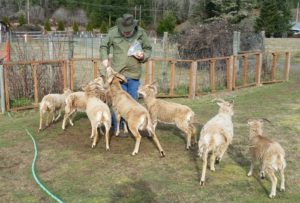
Treat time for the sheep.
A young Ram we’d named Robbie, who had always been very tame and friendly, was, from a young age, an eager participant in the daily distribution of treats. But one morning in November of 2017, however, he apparently felt Jeanette was not feeding him enough, and out of the blue butted her quite hard in her leg.
At first we thought her leg was just badly bruised, a painful injury but one that would quickly pass. But actually, there had been significant damage to the muscle fibers deep in her thigh, and bleeding deep in the muscle there. About a week after the injury, in the middle of the night her leg suddenly swelled, became extremely painful, and she was unable to bend it, all of which caused us to make a middle of the night run into town to the hospital emergency room. It turned out that the pain and swelling were caused by pooled blood deep in the muscle tissue which her body was trying to dissolve, causing an inflammatory response. When that process was completed, her leg should, the doctors assured us, return to normal. But the muscle did not heal as the doctors had predicted. The pain and lack of full mobility persisted even after the swelling had ended. It turned out that the concentrated impact of the ram’s horn against her leg had damaged the muscle fibers, leaving them twisted and knotted. Ultimately, Jeanette had to begin a course of twice per week physical therapy in Eugene, involving massage, stretching, and strengthening exercises, to gradually restore the muscle fibers to their normal configuration. It was a slow process, which continued from late December 2017 through April of 2018.
We have come to love living in the country, but there are a few downsides. Trips to town, which require a drive of a little over an hour round trip, do tend to eat up time and limit what could otherwise be accomplished in a day. Thankfully, Jeanette’s leg eventually fully recovered, but I lost a lot of potential writing time, and we lost a lot of time during early 2018 when we normally would have been beginning the year’s garden, due to all of those twice per week journeys to Eugene. We also had to stop what had been an important part of our weekly exercise and fitness regime: hikes in the hills above our farm three times per week.
As to Robbie, until the attack we’d always found him to be so tame and personable that we did not want to “harvest” him for meat—the eventual fate of most of our rams. We’d thought we would either keep him to eventually replace our existing lead ram, Dammit, or else sell him to someone as a good, tame ram to anchor a small starter herd. We considered neither of those alternatives viable after the attack. Robbie’s future had been changed. It did not happen immediately, but eventually Robbie met his fate. We ate his liver sautéed with bacon and onions for New Year’s Eve dinner at the end of 2018, and enjoyed Robbie burgers this past Memorial Day weekend.
The various problems we’d had during 2017 led to a cascade of worse problems in 2018. By the time Jeanette’s leg was far enough along in the healing process for her to be able to work outside, we were already behind on the garden. So from spring through early summer we abandoned everything else we could—our hikes and other regular exercise, plus my writing—to try and catch the garden up. Although we were somewhat successful, our 2018 garden was definitely the lowest producing garden we’d had since moving to the farm in 2012. Every crop came in later than usual, some produced much less than in typical years, resulting in less for us to freeze for winter consumption, and some types of crops we regularly grow never reached maturity at all.
2018 was also a tough year for me physically. I have thinning discs and arthritis in my lower spine. In the past, it mostly has caused some stiffness and soreness in my back if I worked too long in a bending over position, but during 2018 it worsened into almost constant pain, at its best moderate at times, but fairly severe at others, making the level of physical activity our farm life requires far more difficult and wearing.
On top of the constant back pain, I was very sick for the entire month of August. I have had Multiple Sclerosis since the late 1990s. It is an unusual disease, and there is still much that doctors do not know about it, including what causes it. In MS, the body’s immune system for some reason starts to attack nerve fibers in the brain, or sometimes the spinal cord, as if they are infection or bacteria of some other kind of illness-causing invader the body needs to fight off. The damage to the brain can cause a wide range of effects, depending on the area of the brain affected. Some people with severe MS lose the ability to walk, lose part or all of their vision, and some die from the disease. I so far have been fortunate: my most common symptoms have been mostly pain, fatigue, and sometimes numbness in my arms and/or legs, and even those I do not experience all of the time, but only when the disease flares up for some reason.
There is no cure for MS, although there are drugs that can, in many people, slow the progression of the disease. Unfortunately, the drug treatments don’t work for everyone, and even when they do, many of the treatments can sometimes cause significant side effects, in part because they act by suppressing the body’s immune system, making it potentially more susceptible to other illnesses or infection.
I was on one of the treatments for MS—a weekly injection of interferon—for several years after my MS was first diagnosed in 2003. The short-term side effect of the injections was flu-like symptoms for about 24 hours after each shot. But I eventually also began to develop a more significant side effect, damage to my liver, so the treatment had to be discontinued. Fortuitously, however, by that time Jeanette and I had begun eating the Mediterranean Diet, a diet high on fruits, vegetables, and seafood, and in which only modest amounts of meat, and essentially no processed foods, are eaten. The foods in the Mediterranean Diet tend to have high anti-inflammatory qualities, which seemed to have a very beneficial effect on my MS, because even after I discontinued the interferon treatment, my MS did not worsen. In fact, it gradually improved to the point that while not gone altogether, it very rarely showed itself, and when it did, symptoms would usually only last for a day or so. By 2018, despite not having taken any sort of treatment for MS for well over ten years, I had not had any significant episodes of the disease during that time. My MS had, except for an occasional brief day of pain and/or fatigue, been essentially dormant.
That changed in August of 2018. My MS had a major flare-up that lasted the entire month. In addition to pain and fatigue, I experienced major numbness in my hands and legs, cramping and spasms in my hands, and often significant dizziness. But the daily workload on our farm does not pause for illness. So every morning and evening I would stagger up to the barn and garden with Jeanette, to tend to the sheep and chickens, and water, weed, and harvest the garden—efforts which left me exhausted by the end of most days.
Fortunately, the MS flare-up tapered off in September. But because of all that had happened by then, I had made very little progress writing book 5. Jeanette and I tried to come up with a plan for the remainder of the year that would hopefully allow me enough time during the fall to push and complete, or at least come close to completing, writing the book. Although we usually plant a fall garden, in 2018 we decided not to, to save me time.
But even without a fall garden, we still had a major farm issue to deal with that fall. The drought which had begun in 2017 continued through all of 2018 and into the early months of 2019. Spring rains in a normal year here in western Oregon usually continue, in a gradual tapering off process, into early June, after which the summer months are typically almost rain free. In typical years, our pastures have a growth spurt during the spring, and are quite lush by early summer. But the spring of 2018 was unusually dry, and the grasses in the pastures—already somewhat stunted by the drought of the preceding year—never achieved their full growth. On top of that, our already too-large herd of sheep expanded dramatically during the spring lambing season, so that by summer we had twenty-eight sheep. The combination of the effects of the drought on the grasses’s spring growth and having too many hungry mouths grazing on them wreaked havoc on our pastures, rendering them by late summer almost barren in places. So by the end of summer 2018 we were facing two must-do tasks: we desperately needed to reduce the size of our sheep herd significantly, and also needed to try to rehabilitate several of our most badly damaged pastures.
We blocked off and reseeded several sections of pasture, so that hopefully at least those areas could recover over the winter and in the following spring. We sold ten sheep to a buyer from Washington State, and sold two for meat to a Mongolian family from Portland who wanted whole animals for a traditional christening celebration. We also gave away one of our young rams for butchering to some friends, butchered another for my son when he came for a visit at Christmas, and butchered Robbie for ourselves. In addition, a young ram born during the spring apparently ate something that severely disagreed with him and he died. From all of that, by the end of the year we’d reduced the herd down to twelve: nine ewes, our big, mature ram Dammit, and two young rams to grow for next year’s meat, but the process took time—lots of time.
But 2018 was not through with us. As I mentioned earlier, during 2016 I had begun selling options contracts to generate extra income. It had proved enough of a successful means of generating income that over time I had gradually increased the amount of options trading I was doing. In the fall of 2018, I was holding a significant number of PUTs contracts I had sold, each requiring me to buy 100 shares of a given stock at a set strike price, if the stock’s price per share dropped below the strike. Because I was selling a number of contracts each month, usually with expiration dates three months out, as of the beginning of October I had waves of contracts with expiration dates each month through January of 2019.
In October, the stock market crashed due to jitters over the effects of President Trump’s—who likes to call himself Tariff Man—trade wars with China and almost every other country the U.S. trades with. The effects of the widespread tariffs—which, contrary to what Trump claims, are actually paid by U.S. companies and consumers, not the foreign countries whose products they are levied on—were, and still are, having ripple effects throughout the world’s economies. As just one example, although the service sector of Germany’s economy is still strong, its manufacturing sector is currently showing recession levels of weakness. In the U.S., many farmers who grow bulk crops such as corn and soybeans for export markets have suffered huge losses, and bankruptcies by farmers who grow export crops are up dramatically—all of which Trump is trying to limit, because he needs those farm-belt votes in 2020, by giving certain classes of farmers billions of dollars in Federal bail-out funds (which means our country and its taxpayers are paying for his tariffs in multiple ways, from higher costs for imported goods to billion dollar bail-outs for certain classes of commercial farmers).
The stock market eventually recovered in early 2019, but for three and a half months I got slaughtered on the options contracts I was holding. As stock prices plummeted, the buyers of the contracts exercised them to cut their losses, meaning that over and over, when I would log onto my brokerage account each morning, I would find that I had bought shares of stocks that were now worth far less than I been required to pay for them. Nevertheless, because of the extent of my exposure, I was forced to immediately sell the purchased stocks at a loss, then sell other investment holdings over the three month period to generate enough cash to cover the losses. Instead of the fall being a time when I’d thought to make a hard push to complete book 5, I spent hours online most days juggling our finances trying to stave off disaster. Although I never did a precise tally, by the time the stock market recovered in early 2019 and the bleeding finally stopped, I had lost somewhere around $40,000—and had made no progress at all on book 5.
Although that three month period was more than a little bit of a disaster, I have, over the years of my life, gradually come to recognize that to a remarkable degree, when something bad has happened to me—something that, at the time it happens, feels like a huge setback—I will actually find when I reassess that new opportunities have become available or are coming, and in the end, in the long run, my life shifts in some way for the better if I am open to seeing the new path(s) to take. My financial crisis in the last quarter of 2018 turned out to be just such a positive twist. It was a true trust fate experience.
First of all, it convinced me that options trading is not a viable long term solution for producing extra income. When the economy is strong and growing and the stock market is rising, it can be profitable. But sooner or later, the economy always takes a downturn and the market falls, and the risk of trading options when that happens is just too great. I believe that is especially true now. Although the U.S. economy may currently look strong by many measures, whether our stable genius president understands it or not, our economy is inextricably linked to the global economy, which is weakening in no small part due to his trade wars with seemingly the entire rest of the world. More and more economists are predicting that we will fall back into a recession, possibly a severe one, by 2020, and a growing number are saying a recession could begin this year. My 2018 financial pain made me realize that to protect Jeanette’s and my financial security, I need to act now to build us a stronger, safer source of extra income.
That realization brought me to another one. As I mentioned earlier in this overly lengthy post, I have invested in the stock market for many years. Over time, I eventually came to focus most my investing on companies that paid a dividend to stockholders, and that dividend income was the source of our extra, supplemental income when we first made the leap to this new life. Those investments were paying, when averaged together, probably somewhere around 3% to 4% per year. In order to make up for the extra income option trading had been producing for me when it was going well, I needed to at least double that. Fortunately, I have found a way. It requires a two-step process that is still ongoing, though I’m getting close to completion. First, I have been identifying safe investments that will pay from 8% to 10% per year, and second, I have been plugging enough funds into those investments to generate the level of income we need to meet our monthly expenses.
I’m going to explain more about the first step in a minute. But first let me briefly cover the second one. I’ve been investing in stocks for probably close to thirty years now. As I mentioned above, over time, I’ve come to primarily put new money into dividend-paying stocks. But years ago I did invest in some pure “growth” stocks—companies that don’t pay a dividend to stockholders, but that, because they have been very successful in a niche they created and dominate, have experienced large increases in their stock share price over time as the companies have become more and more successful and valuable—companies like Amazon and Netflix. Over the years, the value of what originally were fairly modest investments I made in those companies have grown quite a bit. I had not done anything with those investments for many years, figuring that they were sort of a nest egg to be held in reserve, one that maybe I would eventually cash in and reinvest in income-producing companies when I got “old.” My wake-up call from my fourth quarter 2018 option disaster, and the need to restructure our finances, made me realize, “Hello, stupid, you are old! You’ll turn 68 this year. What exactly are you waiting for?”
I am going to interrupt this personal story for a moment to strongly urge everyone to try, if you do not already invest in stocks, to find a way to start doing so. If you want financial security, unless you are already wealthy or in line to inherit wealth, you are going to have to take responsibility for building that security yourself. The earlier you start, the better. There are certainly risks involved with investing in stocks. The stock market goes through cycles of growth and crashes. The crashes are scary—in my roughly thirty years of investing, I’ve been through several, the worst of which was the crash accompanying the start of the great recession in 2008. In that one, like many, many investors, I saw the value of my stock holdings drop by at least 50%. These things happen. But the stock market always bounces back, and over time, ends up stronger than it was before a crash. As long as an investor does not panic and sell during a crash—a move that makes paper losses real—but instead holds on to his or her stocks and waits the downturn out, the vast majority will rise again, and eventually surpass where they were before the crash. That, too, has happened to me several times since I have been investing.
I would particularly urge any young adults who are reading this to start building your financial future now. Retirement may seem like something that is a very long way away, but if you do not start planning and saving for it now, when you get older you may find yourself facing the reality that you cannot afford to retire. Beginning is easier than you might think. There are a number of very easy-to-use online stockbroker services. I primarily use E*Trade, but there are a number of quite good others, including Fidelity.com. To get started, just apply to open an investment account and make an initial deposit. Identify what stock(s) you want to invest in (more on that in a moment), and place an order to buy as many shares as you can afford with the cash you’ve deposited in your account. With most good online brokers, the fee to make a trade is quite low: $4.99 is a common rate. And whenever you get a windfall of some extra cash—maybe a tax refund, or you inherit some money when a relative dies—don’t spend it all on something frivolous. Spend at least some of it on your future by investing it.
How do you know what stocks to invest in? I certainly am not knowledgeable enough to research and identify companies on my own to evaluate what to invest in. I rely on experts who are much more knowledgeable than me to do that. There are numerous types of market advisors out there, who sell their expertise and investment recommendations to investors. Some are, to be frank, charlatans. There are many who are not, although the rates of success of their recommendations, and the fees they charge for their investment advice, can vary greatly.
During my recent research while planning how to restructure Jeanette’s and my finances, I stumbled upon two online investment advisers who specialize in investment recommendations aimed at generating a safe but high level of income to help investors build enough of an income stream to live on after retirement. They specialize in analyzing and recommending companies in a little-known niche market called Closed End Funds, or CEFs, which are relatively small mutual funds that specialize in various types of investments. Some of these two analysts’ research they offer for free on a public access website: https://contrarianoutlook.com/ . To get the full range of their recommendations, though, it’s necessary to subscribe to their premium services. One, the Contrarian Income Report, is currently remarkably inexpensive: $39.00 per year. The other, the CEF Insider, is more costly, at $399 per year, but that still is not unreasonable when compared to other online subscription investment advice services.
There are a number of things I particularly like about the CEF-based investments these analysts recommend. First, most of the funds they suggest pay from 7% to 9% per year, far higher than the rate of return on most individual companies’ dividend-paying stocks, and a few pay 10% or higher. Second, because CEFs are mutual funds that hold a wide variety of stocks and other types of investments, they tend to be more stable and less risky than investing in individual companies (although a flip side of that spreading of holdings and risk is that CEFs will likely never experience the huge levels of growth that can be possible to achieve with a fortuitous investment in a break-out growth company, such as an Amazon—but those don’t come along every day). Third, the Contrarian Income Report offers a proposed portfolio of CEFs and other funds that pay monthly dividends, especially geared toward providing a steady stream of income for retirees, which was exactly what I needed. And last, a majority of the recommended CEFs have quite low share prices, most near or under $20.00 per share, and some under $10.00, which makes them very appealing and accessible for beginning investors with only modest amounts to invest with at any given time. Just as an example, one fund they recommend, the Liberty All-Star Equity Fund (stock symbol USA), currently costs only around $6.20 per share, and pays an approximately 10% per year dividend. So please, if you do not invest, give serious consideration to beginning, and if you’re already an investor, consider taking a look at what these two analysts are recommending. We all have to take care of ourselves and our families, and that seems to be getting harder and harder to do in this country these days.
End of the infomercial, and back to my story. As 2018 finally ground to an end and 2019 began, Jeanette and I resolved to regain control over our lives. On the financial front, I have been selling off all of our prior stock holdings, and reinvesting the funds in high-paying CEFs, and have been closing out selling options contracts. Soon, I will be finished with our financial overhaul, at which point my “job” as our investment manager will once again require relatively little of my time and attention.
I have also been working at reclaiming a better level of health. An x-ray of my lower back revealed that the arthritis there has caused a portion of the spine that is supposed to be curved to become straight, which was causing my constant pain. My doctor referred me to physical therapy to try to counter that, but I quit after going for two sessions, during which the therapist tried to show me “safer” ways to do things like get up out of a chair, or get out of bed—he really didn’t grasp the lifestyle I am living. Instead, Jeanette and I have resumed doing a yoga workout together once or twice per week—something we had been doing up until things went crazy in 2017. The stretching and strengthening yoga provides has brought a dramatic improvement to my back. We have also resumed regular workouts with weights, and our regular hikes in the hills above our farm, both of which we had dropped during the struggles of 2017-2018.
I also began a doctor-patient relationship with a MS specialist in Eugene, and had a MRI scan of my brain. Unfortunately, that did show new damage, which presumably occurred during the August 2018 flare-up of my MS. I have not yet decided to resume taking medicine for MS (there have been a lot of new drugs developed for it in the ten-plus years since I stopped the interferon injections) because of my concerns about their side effects possibilities, but I’m keeping a watchful and wary eye on any incidents of symptoms, which unfortunatelyhave been occurring somewhat more frequently than in the past.
Although so far the current “rain year” for this area—the measurement of rainfall that tracks the rainy season, and runs from October 1st through September 30th—is at about ten inches below the historical normal (but is there such a thing as normal weather anymore?), we did have lots of spring rain, and that has done wonders for our pastures. The ones we reseeded last fall, in fact, are lusher than we’ve ever seen them, and will provide us an abundance of hay, as well as ample grazing for the sheep. We will need to reduce the herd size again during late summer or fall—that is going to be an annual task going forward—but at least the situation is not dire like last year.
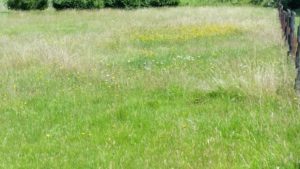
This now-lush pasture was almost barren in places by the fall of 2018.
We also have tried to reduce the size of our garden somewhat, for this year at least, to hopefully free up more time for me, although it is still a large garden. The spring and early summer are always extremely busy until all of the various crops are in, and this year has been no different, but we are nearing completion of that process. We will see how the summer goes—how much I am able to get back to writing—and decide based on that whether to plant much of a fall garden. We are trying to clear time for my writing.
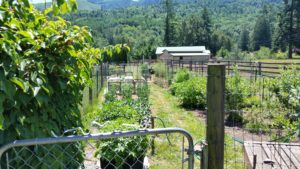
Our garden is almost completely planted now.
Of course, there are always things that happen to disrupt even the most careful of plans. In late February, this area had a freak blizzard, with over eighteen inches of snow falling in about 48 hours. The snow was unusually wet and heavy, and broke or brought down trees all over this part of the state. Power outages were widespread—we were fortunate to only be without power for 24 hours, but some areas were without power for up to two weeks, and a few small communities were cut off from the outside world for that long due to the roads to them being blocked by numerous fallen trees. On our farm, we had a number of trees with heavy limb loss, and several fence lines that were broken in places when the fence posts broke from the weight of the snow. Dealing with all of that damage has taken time, and there is still some fence repair to be done.
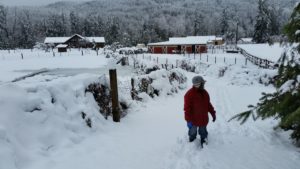
The surprise blizzard of late February 2019 did a lot of damage, bringing down numerous trees across the region and breaking several areas of fence on our farm.
Nevertheless, so far 2019 has been a positive year. Jeanette and I rejoice in this life, in its beauty, the closeness to nature, and even in its challenges, and we are thankful to have the opportunity to spend every day together, sharing this incredible experience. We will continue to search for ways to restructure our lives to give me writing time. Don’t give up on me. I will get books 5 and 6 to you, and finish The Strongbow Saga.
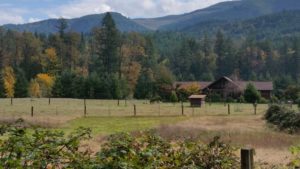
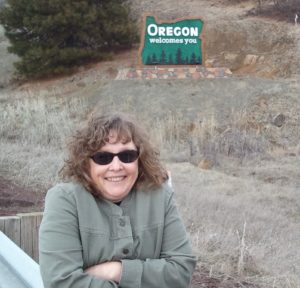

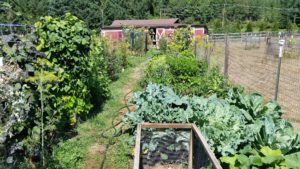
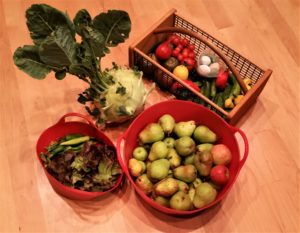
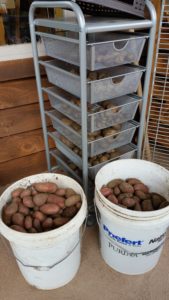

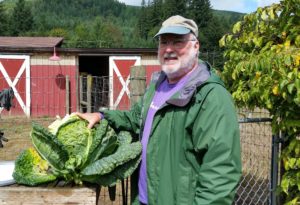

















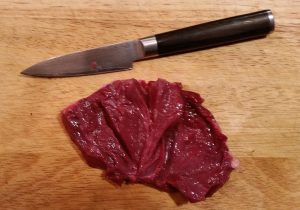





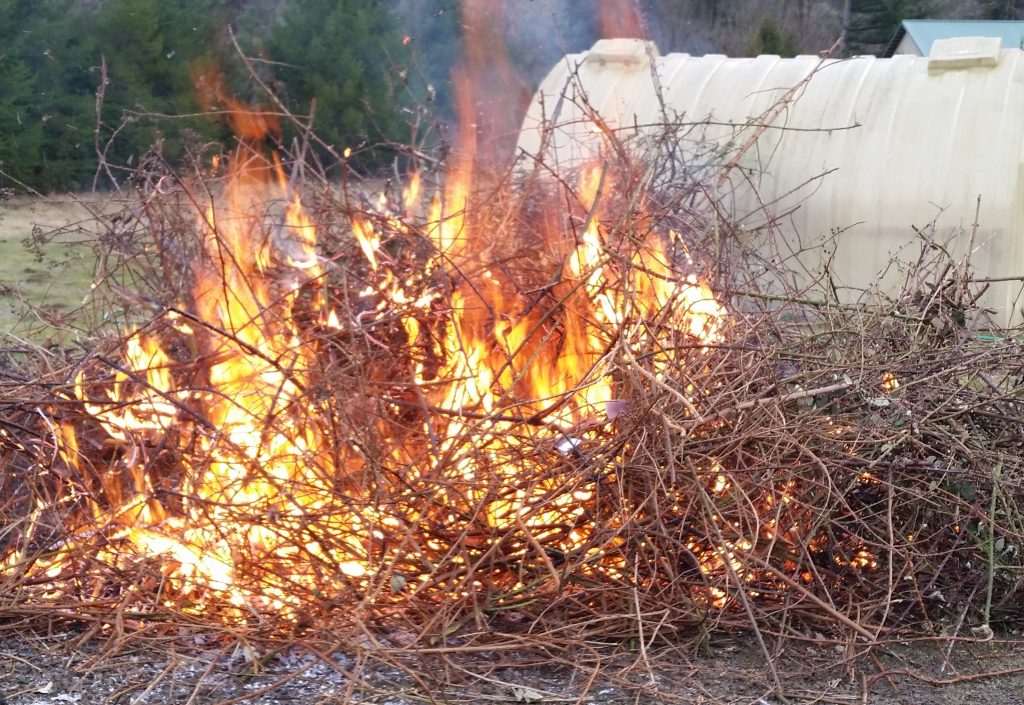
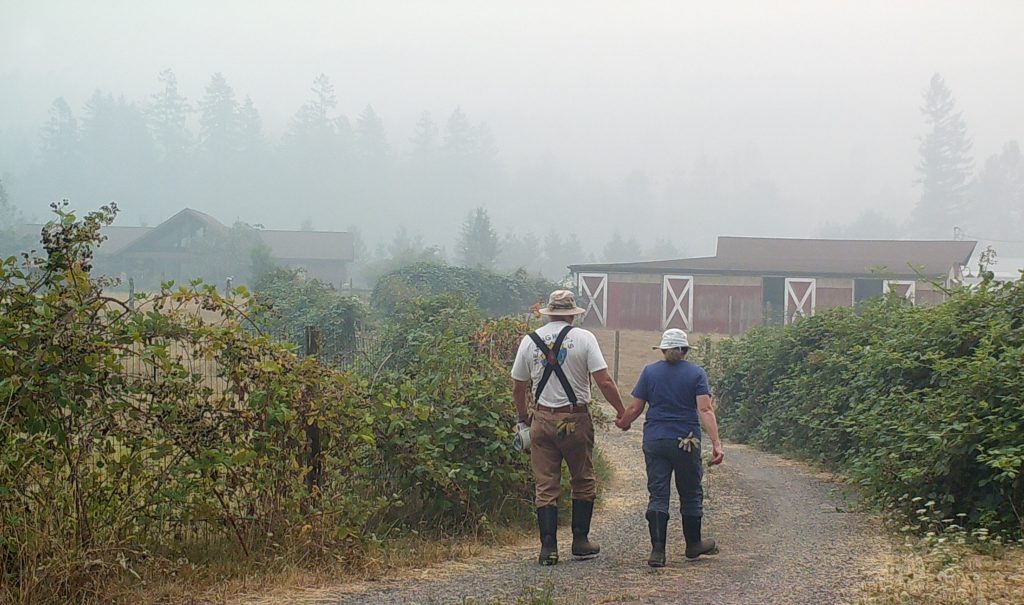



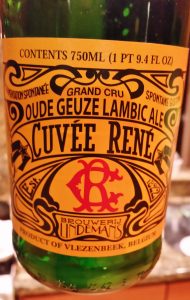 Add the mussels and ale, and stir to mix with the leeks and fennel. The cookbook’s authors suggest, for authenticity, using a Geuze, a Belgian ale fermented in open vats with naturally occurring airborne yeasts, which would be similar to Viking-era ale. The photograph is of the label of one such I was able to find, but if you can’t find a Geuze, you can substitute a medium-bodied modern ale. Just try to avoid one that is heavily hopped, as hops were not known to be used in Viking brewing, and will impart a more bitter taste than an unhopped ale would have.
Add the mussels and ale, and stir to mix with the leeks and fennel. The cookbook’s authors suggest, for authenticity, using a Geuze, a Belgian ale fermented in open vats with naturally occurring airborne yeasts, which would be similar to Viking-era ale. The photograph is of the label of one such I was able to find, but if you can’t find a Geuze, you can substitute a medium-bodied modern ale. Just try to avoid one that is heavily hopped, as hops were not known to be used in Viking brewing, and will impart a more bitter taste than an unhopped ale would have.